Ducati Scrambler Urban e-Bike

If you’ve had your eye on a Ducati two-wheeler, there might just be a less expensive way to get your foot in the door. Their new Scrambler, however, isn’t a motorcycle. It’s the brand’s new…

If you’ve had your eye on a Ducati two-wheeler, there might just be a less expensive way to get your foot in the door. Their new Scrambler, however, isn’t a motorcycle. It’s the brand’s new…
It’s here — the Ducati Panigale V4, in commemoration of the 25th anniversary of the 916 superbike. Just 500 units will be made. So act fast if you want to get your hands on one of the most iconic bikes to ever come out of the Borgo Panigale factory.
Underneath the new Panigale is a handful of special parts. Among them are an Akrapovic exhaust, a dry clutch conversion, and a Panigale V4 R front frame. You’ll also find forged magnesium wheels care of Marchesini here. Not to mention other bits and bobs straight out of the Ducati Performance catalog.
“In all of modern motorcycling history, no bike has been as era-defining as the 916, both in terms of design and performance.”
That’s Francesco Milicia, Global Sales VP of Ducati Motor Holding, speaking at the unveiling event at Pebble Beach.
“I’m incredibly proud to present this exclusive version of our Panigale V4, itself a celebration of the 25th anniversary of the 916.”
Ducati presented the bike with none other than “King” Carl Forgarty himself. Fogarty took the Ducati 916 Superbike to victory twice in the World Superbike Championship. Presenting it on the American Superbike stage, says Milicia, underscores the automaker’s dedication to the US market. He adds he’s sure bike enthusiasts and collectors alike will appreciate the uniqueness of the new Ducati Panigale V4 25th Anniversary 916.
Bike number five from the 500-unit allotment is going up for auction. Proceeds will go to a fundraiser for a charitable cause. Hit the link below to find out more.
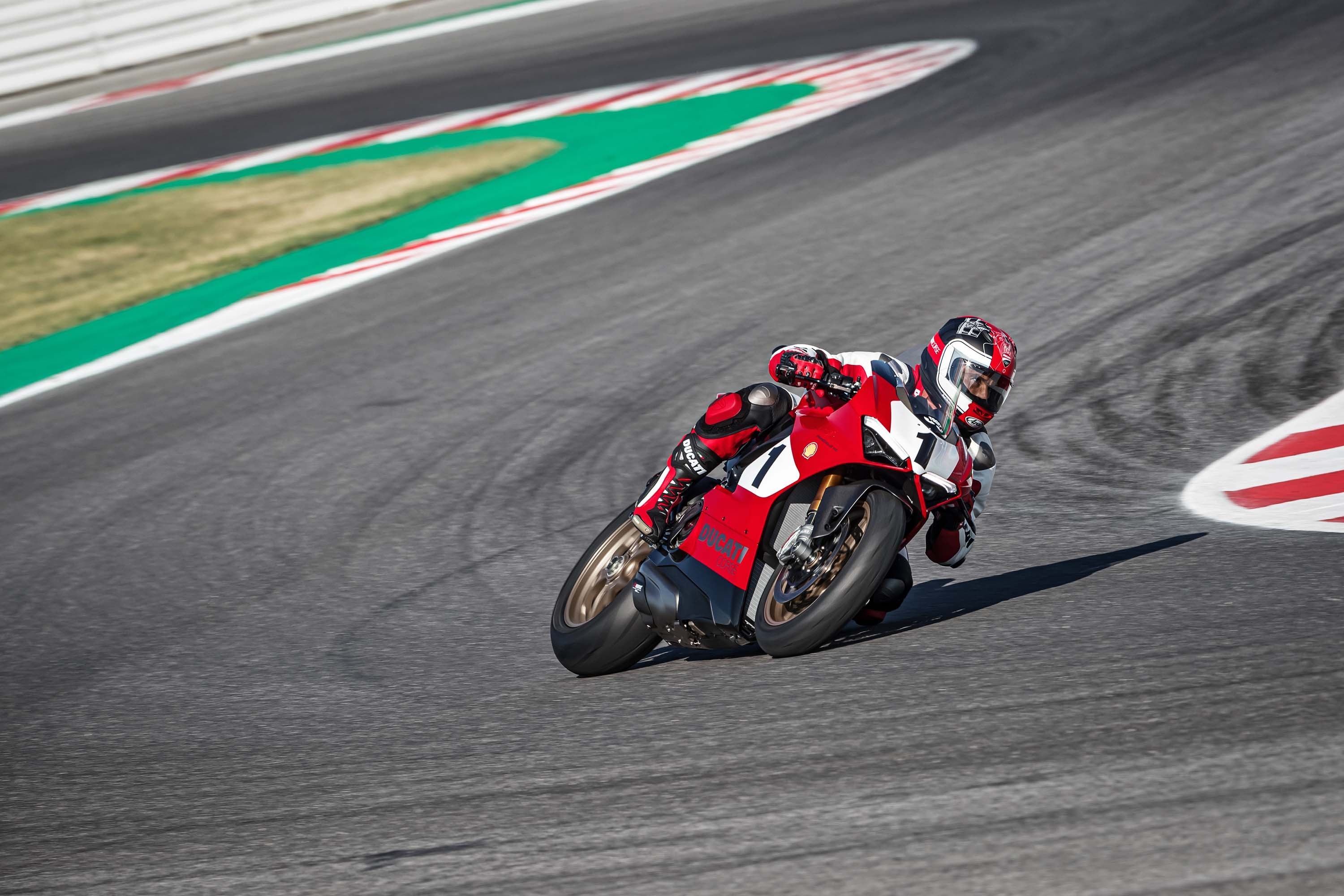


Photos courtesy of Ducati
The Ducati Scrambler Desert Sled is one of the company’s most formidable off-road-ready bicycles. And it’s also beloved by the moto community thanks to its sheer beastliness. After the iconic Alaskan build, which pushed the envelope even further, Alex Earle, based in Los Angeles, has decided to come out with a worthy sequel. Meet the Ducati Alaskan Junior.
The Alaskan Junior, as the name implies, hews from the base inspiration and plays off the bike’s many merits. Suffice it to say that it’s not a better bike by any stretch of the imagination. However, it does have the same design principle, silhouette, and powertrain as its father. That means it’s every bit as powerful and off-road-ready.
The reason why the Alaskan Junior exists is that Alex and his team at Earle Motors wanted to make a bicycle that’s not as intimidating as their most recent ride. So they went back to the drawing board. They reinvented the platform and made a stripped-down version that’s just as brawl-ready when put on the desert.
The main highlight of this custom job is the set of swingarm extenders. This enables the implementation of true off-road wheels and tires. That means riders get to enjoy Pirelli Scorpion XC rubber and performance-oriented Ducati hubs.
If you have a Desert Sled and this looks scrumptious, hit the link below to know how to dress your ride with Earle’s refined parts. We imagine it’s not going to be cheap, but do inquire to get a full list of options and pricing.

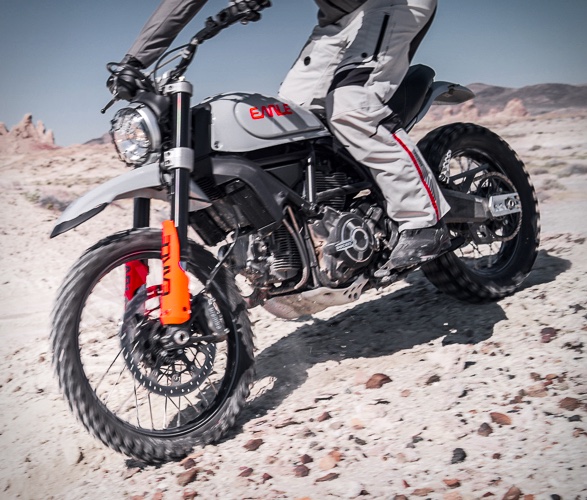


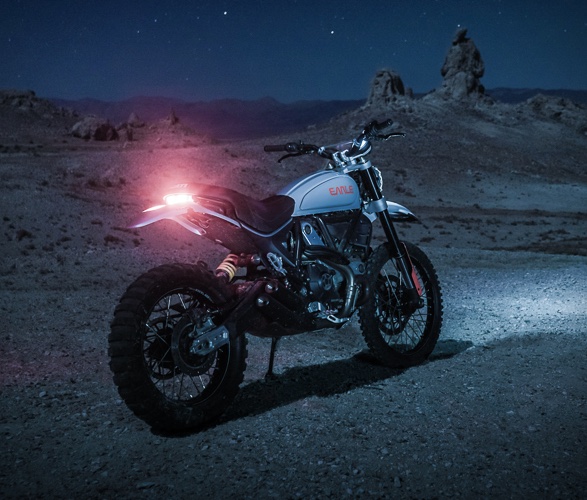
Photos courtesy of Earle Motors
If you saw a Ducati Diavel blazing down the street, you’d never mistake it for anything else. Just the motormaker’s signature high-brow style is enough to clock one in the wild, including both its sports bikes and cruisers.
Ducati has exciting plans for its Diavel for this year. The 2019 Ducati Diavel 1260 marks the second-generation release of this beastly platform. It now comes with upgraded specs, a better trim, and an overall presence that packs even more oomph than before.
The first Diavel 1260 model was released in 2018. It came equipped with a six-speed Testastretta DVT 1262 engine that features Desmodromic Variable Timing. For the uninitiated, that’s Ducati’s own valve operation. It enables optimal valve events from the first rev of the engine all the way through the bike’s highest RPM range.
On the 2019 Ducati Diavel 1260, you’ll find a 1,262cc engine that squeezes out roughly 159 horsepower and 95 foot-pounds of torque. There’s also an upgraded chassis with Bosch cornering ABS and a reworked riding position. That should pretty much keep you in good company when it comes to handling and control.
If for some reason that this Ducati Diavel configuration doesn’t sound all that impressive to you, do know that an “S” model, focused on performance, is arriving sometime in February. It’ll come with an upgraded Ohlins suspension, better brakes, and Quick Shift Evo as standard.
Here’s a bike that perfectly combines the performance of a maxi-naked with the ergonomics of a muscle cruiser. In other words, its classic Diavel on steroids. And if that’s not enough to get you to write a check, you’d be missing out on a supreme ride.



Photos courtesy of Ducati
You don’t need an introduction to Ducati even if you aren’t that well-versed on motorcycles. Everyone knows they make sleek, powerful, and above all, sexy bikes that can seriously tear up tracks. Continuing that whiz-bang rampage is the just-unveiled 2019 Multistrada 1260 Enduro.
With a horsepower of 158 thanks to the Testastretta DVT 1262 engine coupled with a six-speed transmission, the Multistrada Enduro is a sure-footed beast. But that’s just one of the things that makes this bike a worthwhile catch. You’ll be pleased to know that Ducati also threw in a renewed chassis for improved low-speed maneuvering, a Skyhook Suspension Evo system for utmost versatility for on- and off-road adventures, and plenty of new additions via the built-in electronic instrument panel.
Ducati also gave the Enduro a bigger set of wheels, not to mention a Bosch cornering ABS system. You’ll find eight-level adjustable traction control and two-way quick shifter for faster up or down shifting as well. That’s on top of vehicle hold control for uphill starts. You get all that technology and more, like smartphone integration on the handlebars, a remote starter, cruise control, and LED lighting.
The Multistrada 1260 Enduro engine also has a new alternator cover that houses a new, advanced gear sensor. This change is necessary for the Ducati Quick Shift Up & Down system which allows clutchless upshifting and downshifting. You get four modes, including Sport, Touring, Urban, and Enduro, and each feature specific settings for the suspension and electronic suites. By the way, nearly everything can be customized to your liking.
You can choose between Ducati Red or Sand colorways once this ride hits dealerships in 2019.
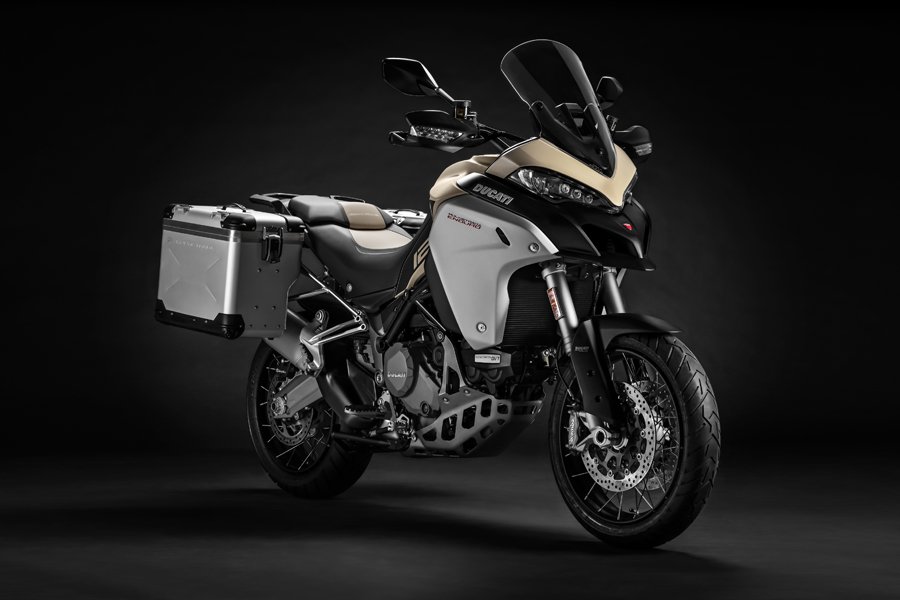

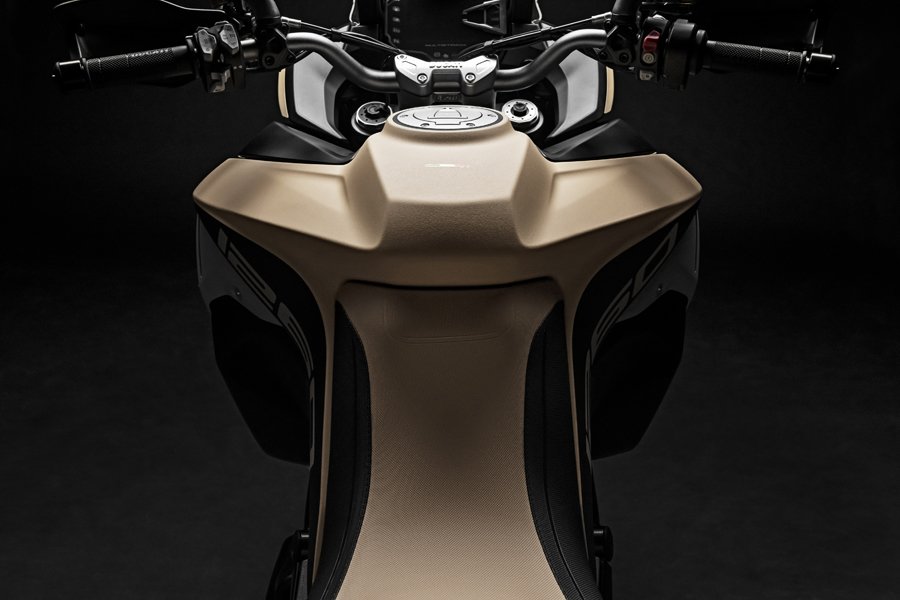
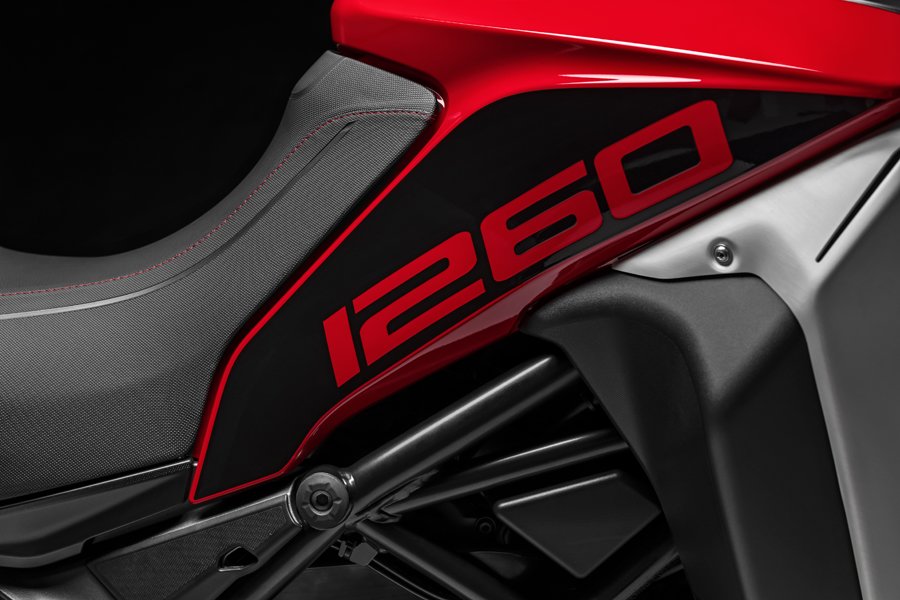


Photos courtesy of Ducati
An Automobile report looks into what’s happening on the organizational and technical sides of the Volkswagen Group, and what those changes could mean for the premium brands. The wide-angle view is that Porsche appears to have been anointed to “coordinate the future activities” at Audi, Bentley, Bugatti and Lamborghini. Audi would cede Lamborghini guardianship to Stuttgart, and Ducati — via a new concern called Ducati Enterprises — would become the shepherd for VW’s other Italian investments. Executives target Jan. 1, 2019, to complete the reshuffle.
VW wants to save a boodle by tying up four of its five top-tier brands, and putting the one with the highest ROI in charge. Porsche, within its own house, wants to reduce expenditures by $2.3 billion per year over for four years, the savings already earmarked for improving internal processes like R&D and production. Having Porsche share those gains as well as lead development of platforms, components and future-tech strategies for the sister sports car brands could benefit everyone.
In the near-term, the brands have their own plans:
Bugatti CEO Stephan Winkelmann is said to want a Chiron Superleggera, a roofless and “completely reskinned” Chiron Aperta, and a track-only Chiron SS. The Superleggera could take the Chiron Sport‘s and Divo‘s Jenny Craig routines even further. The Aperta seems a natural successor to the Veyron Grand Sport, a natural evolution of the recently introduced Sky View roof, and a reskin might include numerous Divo cues. It’s also said Bugatti’s considering “an all-electric high-end model” in conjunction with Porsche, Rimac, and Dallara, but name one supercar or hypercar manufacturer that isn’t considering a lightning-fast EV.
Lamborghini, deep into work on follow-ups for the Huracán and Aventador, might get a bit of a bump with the new plan. The carbon “monofuselage” for the next V12 flagship is said to be too far developed and too complex to scrap. It puts two electric motors on the front axle, batteries in the middle, and a naturally aspirated V12 with around 770 horsepower plus another e-motor with 402 horsepower in back.
The Huracán is said to get a version of the same carbon architecture at the moment, but the corporate reorganization might press pause on it. Automobile says options include continuing the Huracán/Audi R8 twinning, but that depends on Audi saying “Ja” to a third-gen R8 with Lamborghini bones. Beyond that, the Huracán could move to the Mimo II platform created by Porsche for the in-limbo-since-2011 mid-engined 960, or the entire premium group could get a new aluminum architecture for a “modular multi-brand sports car.”
Bentley and Audi need the most help at the moment. The UK carmaker needs to flesh out its current financial issues and vision for the future, and the latter relies in large part on the former. Audi remains in upheaval — the Automobile piece calls the brand “seriously overstaffed and worryingly over budget.” — and we can’t know when that will end. The ex-CEO who made the brand VW’s highest earner remains in jail, and we wouldn’t be surprised by any new bombshell that drops when he gets his days, or weeks, in court.
A total reintegration, if it all comes off, means monumental work. Yet according to a Bloomberg corporate analyst, potential rewards from going all the way with the plan might make it impossible to resist. Bloomberg said that if VW created a premium group and floated it on the markets, the result “could be valued at more than 120 billion euros,” when the stock market capitalization of the entire VW Group right now is 67 billion euros.
Related Video:
The Ducati SuperSport came back in 2017 from a 10-year hiatus to bridge the gap between the upper echelon of the Ducati lineup and more approachable bikes. The SuperSport brings the elegant, looks-fast-standing-still design and technology from the Panigale to riders who aren’t used to reigning in 200 horsepower on a daily basis.
High strung sportbikes are one-trick ponies, as eye-catching and blisteringly advanced as they are. Bikes that are born from racing but adapted to the streets while still retaining impressive stats are compromised for everyday riding. Ergonomics, torque curves and power bands well-suited to produce lightning fast lap times are a bike’s most significant weaknesses on a daily commute while dodging traffic going from stop light to stop light. The Ducati SuperSport S cherry picks the best aspects from longer distance bikes and the sport bike world to give the average rider a taste of top-tier Ducatis on a daily basis.
The Good: Styling on the SuperSport is one of its main draws. What used to be out of reach for most riders — those who didn’t want a high-performance track machine but adored the styling — can now enjoy one of Ducati’s best designs in years.
A host of electronic aids and layers of menus let riders customize the character of their bike. You and a friend could both get a SuperSport, but through the eight-level traction control and three level ABS system, you can mix and match the computer’s level of intervention so much that you could share the same bike but have two completely different experiences.
Who It’s For: Commuters who are looking for a premium bike to use almost every day but don’t want the aggressive and cramped ergonomics of a track bike.
Watch Out For: The SuperSport only comes in two colors, but there’s a catch. The base model just comes in red, so if your heart is set on the white, you ‘ll have to spring for the S model and throw down an extra $1,700. And if you can live with red, a non-adjustable suspension and adding an optional quick-shifter, I’d stick with the base model, because those are the only differences.
One of the most egregious flaws of the SuperSport is undoubtedly its mirrors. I’m somewhat broad-shouldered, so with the SuperSport’s mirrors on such short stalks I had to keep pinching my shoulders and elbows in to get a view of what was behind me. That annoyance, however, had nothing on vibrations that rendered the mirrors all but useless at night. A bike with that big of an engine, with so few cylinders will, of course, not ride very smoothly — there are bound to be vibrations and a lot of them. The mirrors vibrated so much that during the day my rear view was closer to a French impressionist’s interpretation of reality and at night, I gave up entirely and just used quick glances over my shoulder.
Alternatives: The only real direct competitors are the Kawasaki Ninja 1000 and Suzuki GSX-S1000F. Both the Japanese bikes are more powerful than the Italian at 140 hp and 148 hp respectively and also both get power from inline-four engines, affording a smoother ride.
All three have similar price tags and multi-level traction control systems, but the Ducati is the only bike of the three to offer fully-adjustable suspension, three ride modes (Sport, Touring and Urban) on top of the eight-level traction control system and three level ABS.

Review: I never got the chance to take the SuperSport on to a track to explore or even get close to the limits of what can do, but then again, the majority of riders picking this bike up won’t either. In my week with the SuperSport I commuted back and forth from Manhattan to Jersey City through the Holland Tunnel during a heatwave, did a few highway blasts on the way to see friends and took a trip down to the beach for the weekend. In other words, I lived my life as I usually would, I just happened to have a Ducati underneath me. And, for an everyday rider, the SuperSport followed through on Ducati’s promise of versatility and performance.
I already had it in my head that Ducati’s idea of a ‘comfortable’ sport bike was simply bolting the footpegs lower on the bike and calling it a day. And with styling so close to that of the Panigale superbike, it was all too easy to write the SuperSport off almost immediately. Getting proved wrong the second I sat on the bike was the most jarring moment of the entire week.
Yes, the pegs are lower, opening up more leg room, especially for taller riders, but so is the seat. Combine that with the raised position of the handlebars and I was sitting nearly bolt upright. On longer rides or even short bursts through the city where body position is continuously changing, that freedom of movement affords the rider back an incredible amount of endurance.
In slipping in and out of traffic to and from work, useable torque is the SuperSport’s calling card. If the SuperSport boasted superbike performance to match its looks, all the power you need would be comically high in the rev range. Instead, Ducati moved most of the torque to just above 3,000 RPM, so you can ride around at a pace which won’t earn you any tickets or summons, but you can still get your money’s worth from the power you paid for. You can thank the punchy 937cc L-Twin for that because the more rev-happy inline-four competition from Japan make you go searching for power above the 9,000 RPM mark, which can be useful on the highway but you’ll rarely see that on city streets.
The engine gives the Ducati trademark vibrations throughout the bike — it renders the mirrors absolutely useless and becomes temperamental at low speeds, on light throttle. Trundling through the Holland Tunnel, where there’s no passing and traffic moves at crawling pace on a regular basis coasting was difficult. At low RPM, power delivery was choppy, causing the bike to jerk slightly. I wasn’t anywhere near the point of stalling the bike; the engine just didn’t like the lazy pace — noting the bike’s air-temperature thermometer read 122 degrees Fahrenheit in the middle of the tunnel, neither did I.
Verdict: If you look at the price tags and performance numbers alone, the Ducati doesn’t sit at the top of its class. The Kawasaki and Suzuki easily beat it out there, offering more power for the same if not less money. But – and this is very big, obvious ‘but’ – numbers aren’t everything.
The full experience on the Ducati SuperSport is more than just numbers. Superior design, sound and the way it effortlessly takes on corners are the reason anyone leans towards a Ducati. Throw in the everyday usability of the SuperSport and you know have a beautiful bike, packed with performance and technology, without the torturous ergonomics of a superbike set up as a track weapon. The engine does have its flaws but as a whole package, Ducati scored a major win by opening up more riders to the more exclusive and intimidating part of the dealership.
What Others Are Saying:
• “Ducati may have designed this ride to bridge the gap between the laid-back riders and the more spirited ones, but the look is all sport and distinctly Ducati.” — Top Speed
• “Agile on city streets, comfortable on the motorway and superlative on out-of-town twisties, the SuperSport is super-versatile. Relaxed rider and passenger positions, good airflow deflection from the height-adjustable Plexiglas screen and the mileage provided by the 16-liter fuel tank also make the Ducati SuperSport a cool companion on medium-distance rides.” — Total Motorcycle
• “The SuperSport S is marketed as perfect for road riding without compromising its sporting spirit, to paraphrase Ducati. The subsequent lack of any soreness after riding definitely backs up that statement. The seating position makes for a pleasant commuter ride, while the handlebar set-up allows you to sit high, and the soft, wide – but not quite Honda Gold Wing wide – leather seat is perfect for stylish road riding.” — The National
Engine: 937cc L-Twin
Transmission: Six-speed
Horsepower: 110 hp @ 9,000 RPM
Torque: 69 lb-ft @ 6,5000 RPM
Weight: 463 lbs
Read More Gear Patrol Reviews
Hot takes and in-depth reviews on noteworthy, relevant and interesting products. Read the Story
Ducati’s best-selling motorcycle has just turned 25 years old, and to celebrate it, the Bologna-based company is releasing a limited edition bike that looks and rides as good as ever.
The Ducati 25th Anniversary Monster 1200 retains its twin-cylinder Testastretta 11° DS engine (147-hp), the fully adjustable 48mm Öhlins fork & rear suspension, and Brembo M50 brakes. The exterior, however, gets an Italian flag color treatment and gold-colored details throughout, such as the steel tube frame and the Marchesini forged rims.
Other high-performance specs include ABS Bosch Cornering, Ducati’s Wheelie Control, Traction Control & Quick Shift Up and Down systems, and a full-color instrument panel.
Available starting this November, in a limited edition of 500 units (with only 100 of those reserved for the North American market), the sharp-looking Monster 25th Anniversario is sure to sell out quickly, so you’d better act fast if you want one.
Learn More From Ducati $20,000



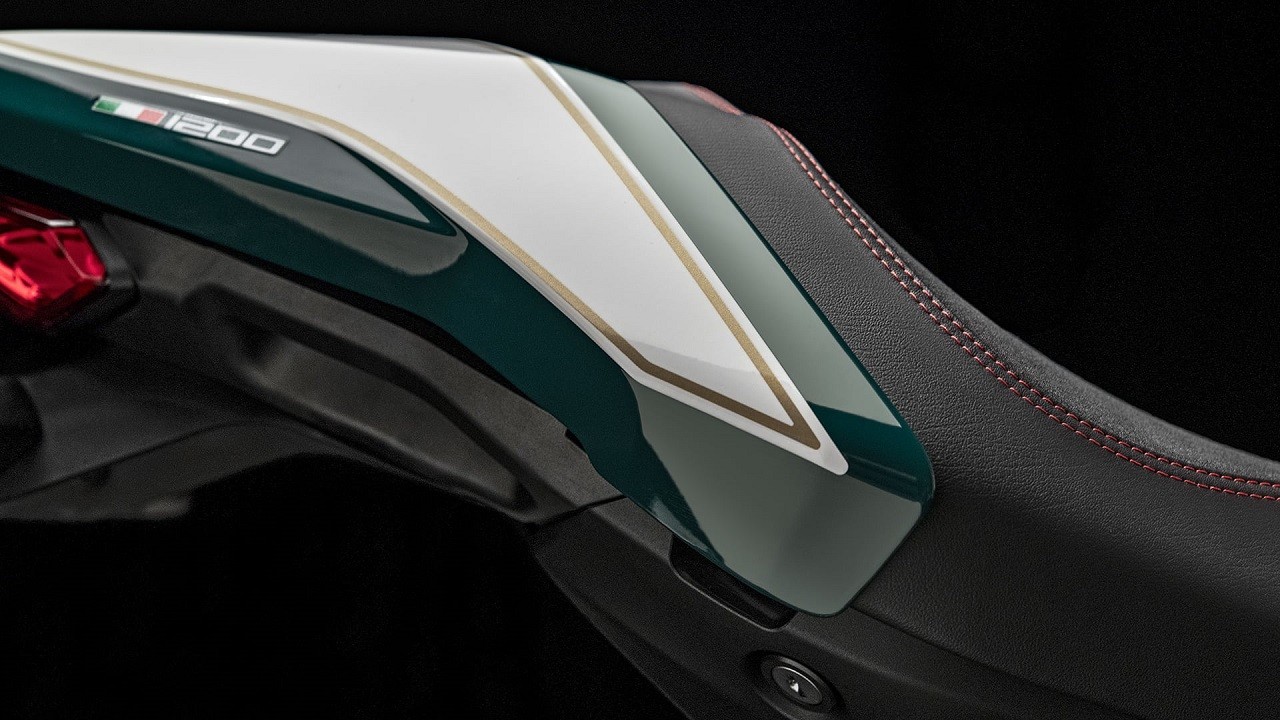

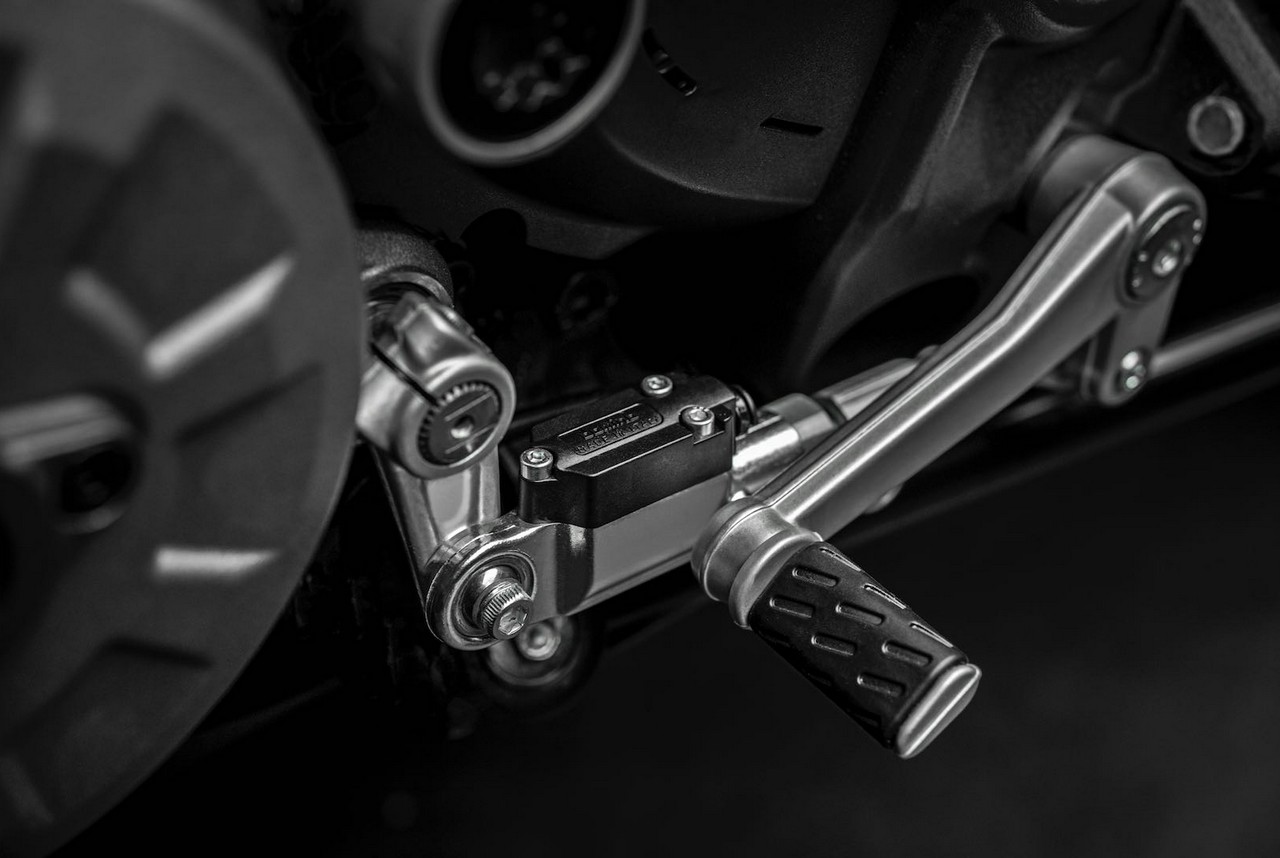
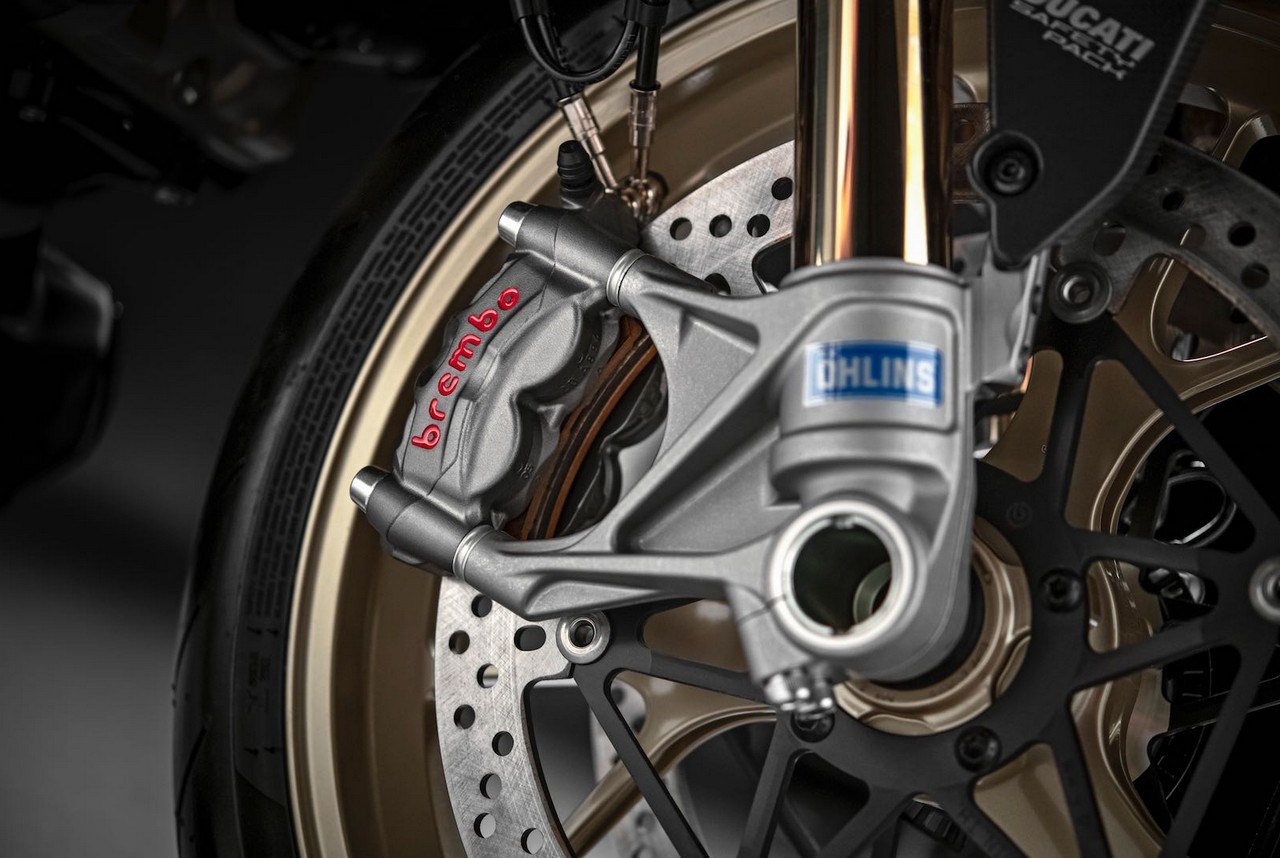


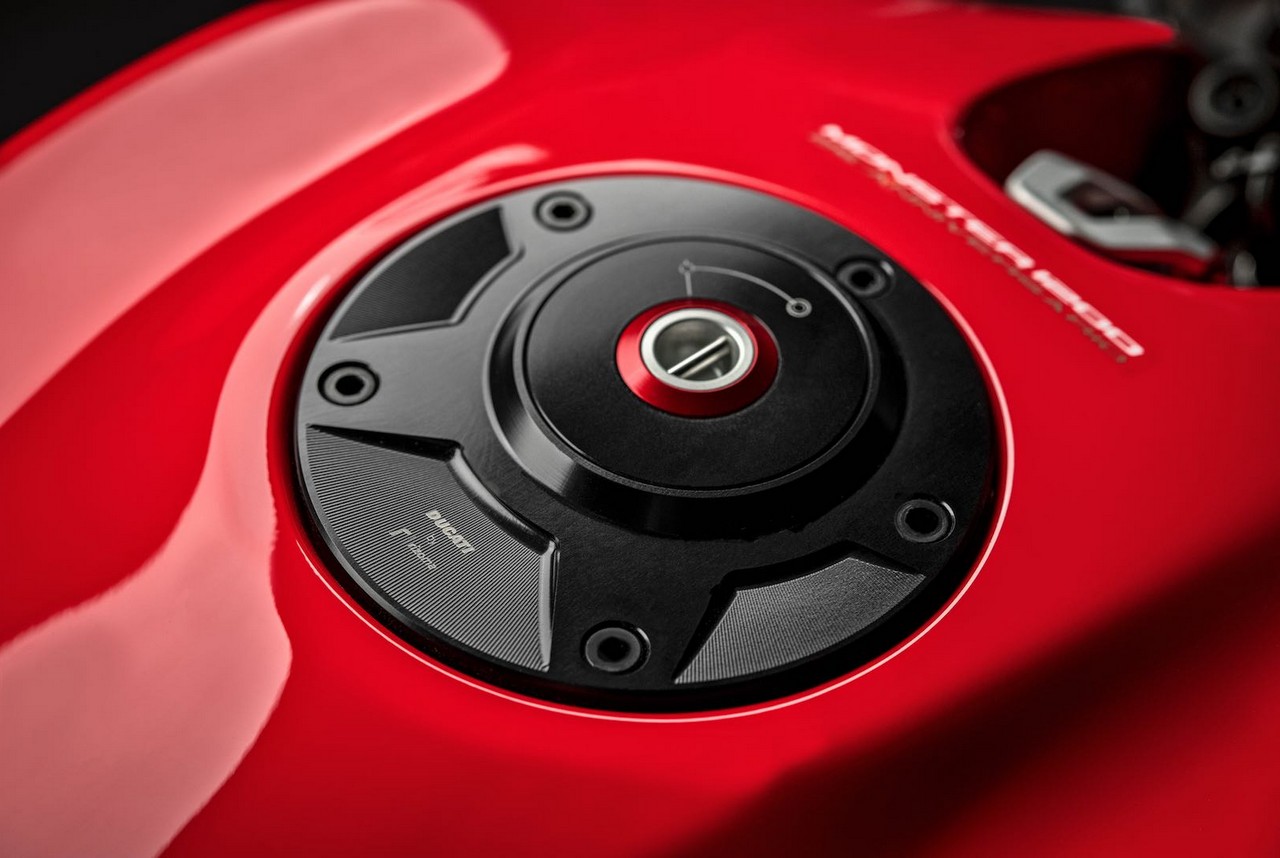

 Photos Courtesy of Ducati
Photos Courtesy of Ducati
This list serves as a guide to commuter, motorcycles. It’s not an official segment of motorcycles, but certain lifestyles demand daily transportation in and out of urban areas, and a small motorcycle is the perfect answer. The five motorcycles included vary in size, style and price but are all perfect for navigating the daily grind.
Prefer to skip directly to the picks? Click right here.

In the Ducati Monster lineup, the 821 risked falling into obscurity as the middle child. The 797 is prized as the approachable, entry-level Ducati since the Scrambler line spiraled off into its own sub-brand. The Monster 1200 might have a near identical design to the little 797, but if you look closer, it’s a tech-laden superbike with no fairings and serious power. Instead of being a slightly bigger version of the 797, the 821 borrows supersport-level tech from the 1200 and brings it down to an approachable level. It gets the best of all worlds — the controllable and lightweight nature of the 797, plus a little extra shove from the engine and the top-of-the-line tech and control systems from the 1200. And it costs just over $11,000.
Who It’s For: The commuter who doesn’t need the power of a bigger engine, but wants the tech that seemingly only the bigger, more expensive bikes get.
What’s Good: “For some, and understandably so, the 147-horsepower Monster 1200 may prove to be too much bike and the 797 too small and rudimentary. The 821 comes in as the Goldilocks option: it utilizes the same frame, brakes, tank and headlight, the beautiful if intricate, color TFT instrument display and traction control and ride mode system as the more expensive 1200 — but delivers it all in a much more manageable, affordable package. That seems to be the magic of the Monster. The Scrambler may be its own sub-brand, but the Monster has its own following under the larger Ducati umbrella. It offers the same styling with different levels of performance, attracting a wider array of riders. It succeeds with an architecture Ducati got right the first time and has simply fined tuned over the years in small, minute increments like Porsche has done with the 911.” – Bryan Campbell
What to Watch Out For: The term ‘all-new’ for 2018 has to be used loosely. “The engine in the new 821 is the same 821cc Testastretta L-Twin engine from the outgoing model but gets a host of modern hardware from the bigger, more technologically advanced 1200. Looking at the 797 and the 821 side-by-side, you might say they’re both entry-level models; if the 797 is the base model, with no options ticked, the 821 is the upgraded sport package. – Bryan Campbell
Value: There are very few other bikes at this price point with this much technology on board, though that much tech is becoming increasingly more common. Aside from the power deficit and the yellow paint job option, the 821 is incredibly similar to its big brother, the Monster 1200 — a bike that starts around $17,000.
Design: “Ducati’s Monster married a superbike engine to a Super Sport frame and created somewhat of a new genre with the “naked” sportbike — a modern cafe racer of sorts. It was an undeniable hit. It was different. It was beautiful. It could handle the canyon roads as well as a race bike could tackle the track and it came with three different engine options: the M600, M750, and M900. Until now, we’ve had the all-new Monster 1200 and 797; and now, the latest update: the middleweight 821. For 2018, in keeping with tradition, Ducati brought its iconic, entry-level roadster into the modern era with an incredibly minimalistic approach.” – Bryan Campbell
Verdict: “The 821 certainly isn’t a paradigm shift in the Monster universe, but what it gets right is bringing upper-echelon sportbike technology within the grasp of new riders — or riders not interested in spending nearly $18,000 for what should be standard on any modern sport bike.” – Bryan Campbell
What Others Are Saying:
“Stylish yet utilitarian, practical yet exciting, thoroughly modern but consciously linked to its glorious past, the 821, like Italy itself, blends opposing forces in a harmonious whole, forging its own identity in the process. The 821 isn’t just the Monster 1200’s little sibling. It’s a user-friendly package suitable for less experienced riders, but it’s also competent and engaging in ways that appeal to riders looking for a motorcycle distinguished, not by a single dominant sensation, but by the parity of its parts in pursuit of motorcycling bliss.” – Cycle World
“By far the biggest change, though, is to the electronics, and this comes in two parts. First, the old, letterbox-esque LCD dashboard has been consigned to the trash can in favor of a thoroughly modern color TFT display. Second, Ducati have thrown a full-on electronics package as standard at the 821 and that means full ride-by-wire with 8-level configurable traction control, three-level configurable ABS, and three engine maps.” – Ride Apart
“In the end, I think the new Monster would make a fantastic and stylish first Ducati for any rider with more than six months of riding experience under their belt. Ducati wasn’t B.S.-ing when it claimed the new 821 is the “Best Balanced Monster.” – Motorcycle.com

In the middle-weight naked bike category, the bikes are so closely matched that any scrutiny has to be done under a microscope. Pricing is all evenly matched, though the Kawi is one of the more affordable options compared to its Japanese rivals (even on the ABS model at $7,399) and also edges out the competition on styling with lively pearl white plastics and an electric green trellis frame. Where the Z650 really shines is under power in the mid-range, right where you need it for passing traffic in day-to-day commuter traffic.
Who It’s For: The rider who wants to save a money rather than shell out for the absolute best in class but still wants to enjoy tight and twisty back roads on the way home from work.
What’s Good: “Team Green developed this bike as the bigger brother of their own monkey-bike, the Z125 Pro. That means power took a backseat to flickability during development. Which is why Kawi only breathed on their tried-and-tested 649cc parallel-twin engine, opting to smooth out delivery and provide grunt where it was needed most — in the mid-range.” — Matt Neundorf
What to Watch Out For: To be a better bike for a wider audience, Kawasaki set up the front forks more lightly sprung than usual. It makes the bike more user-friendly to novice riders but aggressive riders might overdo it and find the front end diving under hard braking.
Value: For a modern, naked sports bike to have this level performance and a $6,999 price tag hanging off the bars, it’s a bargain.
Verdict: “You feel this as soon as you settle into the saddle. During stop-and-go stints in downtown Santa Monica, there were no struggles to stand flat-foot at lights, and the bike never felt like it could get away from me. The revised chassis geometry and slim, straight bars make 90-degree, grid-street negotiations a breeze, meaning this thing will do well for urban commuters too.” — Matt Neundorf
What Others Are Saying:
“In all, the Z650 satisfies nearly all of the prerequisites for an affordable, mid-level, sport-inspired machine. In terms of performance, nearly all of the systems found on the Z650 have massive amounts of potential to take a rider with little to no experience, and allow for a great deal of maturation to take place; a rider can develop their skills for a good while, before stepping to the next rung on the proverbial ladder.” – Ultimate Motorcycling
“As it stands, the bike is a great addition to the Z family, and proof of what Kawasaki has learned from years spent with the Z1000 and Z800 (both of which will be replaced by the Z900 for 2017). And it’s a great option for those naked bike lovers who’ve been waiting for a mid-displacement twin with Team Green badges on its side.” – Cycle World
Navigating any concrete jungle can be hell — especially if you call the asphalt wilds your commute. Driving into the city is certified insanity and public transportation isn’t always the most reliable (which is the understatement of the year for any New Yorker). That only leaves one serious option: a motorcycle. In the city, agility trumps power and bulk is the enemy of timeliness. To get to work on time what you need is a slender, nimble bike that looks good and handles well — here are five of the best motorcycles for any city-dweller.
Sport Standard: A style of motorcycle with an up-right riding position, with handle bars close enough to the rider not to neccesitate and agressive lean or reach.
Naked style: A motorcycle lacking plastic fairings, exposing the engine and transmission.
Twisties: When a road has many, tight and winding turns.
Lane splitting: Riding your motorcycle between the lanes or rows of slow moving cars or stopped traffic. California is the only state in the U.S. to officially legalize lane splitting.
Flickability: The ease at which a bike can be quickly change direction, leaning from one side to the other.
Surviving city traffic — mad cabbies, delivery trucks and frantic commuters — on a motorcycle requires patience, quick reflexes and steel nerves from a rider and it’s crucial the motorcycle itself can keep up. A compact, slender bike is a good place to start. Dodging potholes and traffic and going for narrow or closing gaps between cars is the norm when you’re cruising down a crowded avenue or side street. To be able to get any of that done with ease a good city motorcycle utilized that smaller silhouette by being lightweight and flickakble. Of course, bigger bikes are at a disadvantage there but if they can hide their weight with a nice and low center of gravity, heavier bikes can ride like they’re half the size.
Power is important but only if it’s in a usable spot in the rev range. There’s no use having chart-topping power and torque if you have to be flirt with the redline to see any of it. Motorcycles that work best on city streets have a healthy low- and mid-range — basically where the engine speed lives when you’re coming off light or traveling at traffic speeds.
When you are dipping and diving, weaving your way through town, your attention has to be at an all-time high. And not surprisingly, if you’re not physically comfortable on your bike, you’re going to be distracted. That’s not just the ergonomics of the seating position either. Although it is incredibly important that you’re not stuffing yourself onto the bike and cramping up your needs, riding comfort also stems from a great suspension setup. A super stiff suspension setup, where you can feel every rut, rock and crack can not only be bone shatteringly uncomfortable but can lead to a nervous, twitchy and unsettled bike.
It’s a tall order to build a bike that’s versatile enough to handle city streets and still have the capabilities to hop on the highway to get out of town. But when manufacturers get the formula right, a city-bound motorcycle can be an incredible asset in fighting back the daily grind.

In the Ducati Monster lineup, the 821 risked falling into obscurity as the middle child. The 797 is prized as the approachable, entry-level Ducati since the Scrambler line spiraled off into its own sub-brand. The Monster 1200 might have a near identical design to the little 797, but if you look closer, it’s a tech-laden superbike with no fairings and serious power. Instead of being a slightly bigger version of the 797, the 821 borrows supersport-level tech from the 1200 and brings it down to an approachable level. It gets the best of all worlds — the controllable and lightweight nature of the 797, plus a little extra shove from the engine and the top-of-the-line tech and control systems from the 1200. And it costs just over $11,000.
Who It’s For: The commuter who doesn’t need the power of a bigger engine, but wants the tech that seemingly only the bigger, more expensive bikes get.
What’s Good: “For some, and understandably so, the 147-horsepower Monster 1200 may prove to be too much bike and the 797 too small and rudimentary. The 821 comes in as the Goldilocks option: it utilizes the same frame, brakes, tank and headlight, the beautiful if intricate, color TFT instrument display and traction control and ride mode system as the more expensive 1200 — but delivers it all in a much more manageable, affordable package. That seems to be the magic of the Monster. The Scrambler may be its own sub-brand, but the Monster has its own following under the larger Ducati umbrella. It offers the same styling with different levels of performance, attracting a wider array of riders. It succeeds with an architecture Ducati got right the first time and has simply fined tuned over the years in small, minute increments like Porsche has done with the 911.” – Bryan Campbell
What to Watch Out For: The term ‘all-new’ for 2018 has to be used loosely. “The engine in the new 821 is the same 821cc Testastretta L-Twin engine from the outgoing model but gets a host of modern hardware from the bigger, more technologically advanced 1200. Looking at the 797 and the 821 side-by-side, you might say they’re both entry-level models; if the 797 is the base model, with no options ticked, the 821 is the upgraded sport package. – Bryan Campbell
Value: There are very few other bikes at this price point with this much technology on board, though that much tech is becoming increasingly more common. Aside from the power deficit and the yellow paint job option, the 821 is incredibly similar to its big brother, the Monster 1200 — a bike that starts around $17,000.
Design: “Ducati’s Monster married a superbike engine to a Super Sport frame and created somewhat of a new genre with the “naked” sportbike — a modern cafe racer of sorts. It was an undeniable hit. It was different. It was beautiful. It could handle the canyon roads as well as a race bike could tackle the track and it came with three different engine options: the M600, M750, and M900. Until now, we’ve had the all-new Monster 1200 and 797; and now, the latest update: the middleweight 821. For 2018, in keeping with tradition, Ducati brought its iconic, entry-level roadster into the modern era with an incredibly minimalistic approach.” – Bryan Campbell
Verdict: “The 821 certainly isn’t a paradigm shift in the Monster universe, but what it gets right is bringing upper-echelon sportbike technology within the grasp of new riders — or riders not interested in spending nearly $18,000 for what should be standard on any modern sport bike.” – Bryan Campbell
What Others Are Saying:
“Stylish yet utilitarian, practical yet exciting, thoroughly modern but consciously linked to its glorious past, the 821, like Italy itself, blends opposing forces in a harmonious whole, forging its own identity in the process. The 821 isn’t just the Monster 1200’s little sibling. It’s a user-friendly package suitable for less experienced riders, but it’s also competent and engaging in ways that appeal to riders looking for a motorcycle distinguished, not by a single dominant sensation, but by the parity of its parts in pursuit of motorcycling bliss.” – Cycle World
“By far the biggest change, though, is to the electronics, and this comes in two parts. First, the old, letterbox-esque LCD dashboard has been consigned to the trash can in favor of a thoroughly modern color TFT display. Second, Ducati have thrown a full-on electronics package as standard at the 821 and that means full ride-by-wire with 8-level configurable traction control, three-level configurable ABS, and three engine maps.” – Ride Apart
“In the end, I think the new Monster would make a fantastic and stylish first Ducati for any rider with more than six months of riding experience under their belt. Ducati wasn’t B.S.-ing when it claimed the new 821 is the “Best Balanced Monster.” – Motorcycle.com

In the middle-weight naked bike category, the bikes are so closely matched that any scrutiny has to be done under a microscope. Pricing is all evenly matched, though the Kawi is one of the more affordable options compared to its Japanese rivals (even on the ABS model at $7,399) and also edges out the competition on styling with lively pearl white plastics and an electric green trellis frame. Where the Z650 really shines is under power in the mid-range, right where you need it for passing traffic in day-to-day commuter traffic.
Who It’s For: The rider who wants to save a money rather than shell out for the absolute best in class but still wants to enjoy tight and twisty back roads on the way home from work.
What’s Good: “Team Green developed this bike as the bigger brother of their own monkey-bike, the Z125 Pro. That means power took a backseat to flickability during development. Which is why Kawi only breathed on their tried-and-tested 649cc parallel-twin engine, opting to smooth out delivery and provide grunt where it was needed most — in the mid-range.” — Matt Neundorf
What to Watch Out For: To be a better bike for a wider audience, Kawasaki set up the front forks more lightly sprung than usual. It makes the bike more user-friendly to novice riders but aggressive riders might overdo it and find the front end diving under hard braking.
Value: For a modern, naked sports bike to have this level performance and a $6,999 price tag hanging off the bars, it’s a bargain.
Verdict: “You feel this as soon as you settle into the saddle. During stop-and-go stints in downtown Santa Monica, there were no struggles to stand flat-foot at lights, and the bike never felt like it could get away from me. The revised chassis geometry and slim, straight bars make 90-degree, grid-street negotiations a breeze, meaning this thing will do well for urban commuters too.” — Matt Neundorf
What Others Are Saying:
“In all, the Z650 satisfies nearly all of the prerequisites for an affordable, mid-level, sport-inspired machine. In terms of performance, nearly all of the systems found on the Z650 have massive amounts of potential to take a rider with little to no experience, and allow for a great deal of maturation to take place; a rider can develop their skills for a good while, before stepping to the next rung on the proverbial ladder.” – Ultimate Motorcycling
“As it stands, the bike is a great addition to the Z family, and proof of what Kawasaki has learned from years spent with the Z1000 and Z800 (both of which will be replaced by the Z900 for 2017). And it’s a great option for those naked bike lovers who’ve been waiting for a mid-displacement twin with Team Green badges on its side.” – Cycle World

As far as styling and sound go, the Multistrada can be polarizing. What’s not up for debate, though, is how well the big adventure sport bike rides and tackles turns. The secret is the phenomenal Skyhook semi-active suspension and the clever way Ducati engineers hid the bulk of the Multistrada’s 518 pounds. It has the looks of an adventure bike, but when you start to flick the ‘Strada back and forth, navigating traffic and city streets, it’s easy to forget it can handle a mountain pass or two as well.
Who It’s For: The long distance commuter.
What’s Good: “The high-visibility LED graphic display makes swapping riding modes and adjusting suspension settings a simple task, displaying them in simple, visual terms. With a dry weight of 467 pounds, the Multistrada 1260 feels light and agile, albeit a bit tall (seat height is adjustable from 32.5-33.3 in), which makes maneuvering the bike in and out of parking spaces somewhat difficult if you’re a shorter rider.” — Justin Coffey
What to Watch Out For: “Don’t expect to take the new 1260 off-road, as its 17-inch cast Marchesini wheels are more adept at eating up the asphalt than dirt.” — Justin Coffey
Value: The sports-adventure bike category is a tough one to navigate — nearly every manufacturer offers one at this point and they’re all similarly priced. The Ducati, though, has style to go with its tech and performance.
Design: The Multistrada 1260 feels much like the outgoing 1200cc model. Riding position stays the same – upright, comfortable, with wide handlebars and ample wind protection thanks to the on-the-fly adjustable windscreen. With the longer wheelbase, the new 1260 is more confident in corners, more noticeably so in the faster, sweeping curves on the island of Gran Canaria. — Justin Coffee
Verdict: “Ducati’s Multistrada was designed to offer the owner a variety of options. From taking the long way home to riding the length of South America, the Multistrada is capable of many tasks, although it excels at making twisty (paved) roads disappear into the distance. Locking luggage comes standard (optional aluminum panniers are available from Touratech), as do heated grips, keyless ignition, a tire pressure monitoring system and a quick-shift function (clutch-less up- and downshifts, available on the S and Pikes Peak models). With its upright riding position and multiple ride modes, the new 1260 can transform from a docile urban commuter to an aggressive sport-touring machine with the push of a few buttons.” — Justin Coffey
What Others Are Saying:
“So much of what has made the Multistrada a popular machine since 2010 is captured wholly in the new 1260. The engine is the biggest improvement. Ducati claims six additional ponies over the 1200, but it doesn’t really feel faster. The longer wheelbase makes it less prone to wheelie, I’m sure—mostly it’s how linear the power delivery is that made me smile. It’s happy to lug around town, and has a fat midrange that won’t disappoint.” – Cycle World
“The handling of the Multistrada 1260 is superb for a motorcycle of its size. At a claimed 511 lbs wet and with a 62.4-inch wheelbase, I was pleasantly impressed with how precise and light the front end felt and how quickly the entire motorcycle could be flicked from side to side.” – Motorcycle.com

The heritage line at BMW is a tad confusing. The R NineT that launched the line, though it’s a pretty bike, at $15,000 seems rather tame. It does have the technology and power to warrant a price tag around that limit, but the Urban G/S not only looks miles better, it’s more affordable as well. Granted, though it’s more pared down, tech-wise, it still handles just as well as the R Nine T its based on. A Dakar racer it is not, but while weaving through traffic downtown few things look cooler.
Who It’s For: The rider who wants iconic style and design cues blended into a modern BMW.
What’s Good: “Calling it a new model is a touch misleading, though, because it’s essentially just a restyled R nineT Scrambler — except better looking. A high front fender, nose fairing and the iconic combination of red seat and blue tank graphics over a white paint job bring out the best in the R NineT’s styling. The exhaust differs from the Scrambler’s as well, but the rest of the running gear — like the compact analog-digital combo speedo — is identical. It even comes standard with the Scrambler’s alloy wheels, but the optional spoked wheels (pictured) are the ones you want. As a styling exercise, there’s no doubt the Urban G/S is a home run.” – Wesley Reyneke
What to Watch Out For: Where the original G/S that this bike takes most of its inspiration from was known for dominating Dakar, the Urban G/S is not as off-road savvy. It has a few design touches here and there that would help it do better on a dirt than the R NineT it’s based on, but for the most part, it’s just that: design touches.
Value: It might be a slightly paired down version of the more expensive R NineT, but there’s no doubting it looks better. Saving around $3,000 doesn’t hurt either.
Design: “The Urban G/S’s upright ergonomics make it all-day comfortable, but you’ll eventually pine for a cushier saddle, if you do find yourself in the saddle. Its 485-pound form factor won’t give you supermoto-like levels of handling, but the low center of gravity makes it relatively easy to muscle through turns. It’s a deceptively compact motorcycle.” – Wesley Reyneke
Verdict: “The Urban G/S does have incredible potential to be customized beautifully, to be made unique, to be made your own. If customization isn’t your thing, that shouldn’t turn you away. Out of the box, the Urban G/S is a great-looking and well-performing motorcycle. Even if you won’t actually race across the desert with it, it’ll make you feel like you can.” – Wesley Reyneke
What Others Are Saying:
“The heritage the Urban G/S pays tribute to is reminiscent of the old R80 G/S, a motorcycle that basically invented the adventure-touring category. In its time, dirt bikes were lightweight, single-cylinder machines. The original G/S was a street bike fitted for off-pavement duty, a motorcycle made for exploring. The modern version, the Urban G/S, really is no different..” – Revzilla
“The thing is, while none of the other models have really struck my fancy, I really like the R NineT Urban G/S. BMW seemed more willing to admit the Urban G/S is not an adventure bike but a daily bike for people who loved that first adventure bike and who are moved by the styling..” – Cycle World

There’s an argument to be made that motorcyclists have a better understanding of torque than most. Sitting so close to the fulcrum point at the wheel, with any amount of twist from the engine you can easily feel the forces at work. Now consider that one of the defining characteristics of electric vehicles is their maximum torque is available from zero RPM — full power can be instantaneous and available throughout the rev range. When you need to make a last minute pass or get ahead of traffic off the line, an electric motorcycle can spoil a rider. The Zero DS ZF13.0 +POWER TANK is admittedly on the expensive side for the bike that it looks like, however, having 188 miles per charge is a mileage stat not many other bikes can boast. Efficiency is the Zero DS ZF13.0 +POWER TANK, but the way it sends power to the rear wheel is addictive and a great way to spice up any commute.
Who It’s For: The eco-concsious commuter who has a taste for neo-futurism and appreciates that quality power doesn’t mean paying through the teeth at the pump.
What’s Good: Even without the Power Tank option added, the DS gets better city mileage than almost any other bike in its price bracket or power class. Spring for the Power Pack and the DS ZF13.0 increases its range from 147 miles to 188 miles. In other words, more than enough to stifle any lingering range anxiety.
What to Watch Out For: You’re paying for the battery performance, technology and capabilities. Where the Zero falls short is the overall refinement. The plastics seem to be on the cheaper side of the spectrum. But if you can look past that, the DS’s 188-mile range makes it an incredible commuter.
Value: As mentioned, the plastics and overall refinement of the Zero DS falls a tad short, but the better range and money saved at the pump is really why you’re buying this. It’s no electric-assist pedal bike either. Aside from the lack of exhaust note, this is a genuine motorcycle and should be looked at as such. Not many other motorcycles at this price point can claim the same endurance.
Design: The DS design lands somewhere in the gray area between the dirt world and sports standard city bike. That’s not necessarily a bad thing — giving off the peppy character of a scrambler or dual sport while retaining the practicality and comfort of a city bike helps the DS stand out. Oddly, its the complete lack of noise as you ride by that catches the attention of most.
Verdict: There’s a lot to go back and forth on with electric bikes — the lack of sound, the range anxiety, the lack of gears or on some, the pointless gears. But the DS can handle corners well enough (despite being 457-lbs) and will go further than anything else you have in your garage on two wheels. Not to mention it’s one fewer reason to vist the gas station and give them money.
What Others Are Saying:
“Basically, with some cute bodywork and clubman bars, this bike would be the perfect scrambler. Like all Zero motorcycles, it’s best as your daily commuter, but if you really need to do those 100-mile Sundays in the canyons, or just have a long distance commute, there’s always the power tank, which gives it an additional 25 miles at Highway/City combined. That 25 miles of range comes at a price of $2,695 and 44 lbs of added weight.” – Clean Technica
“Zero DS is pleasurable in virtually any riding environment. It’s not your run of the mill electric bicycle “wannabe” motorcycle, but the real deal. If there were a negative issue, it would be that it’s so quiet that other motorists are often unaware of your presence, requiring extra vigilance on your part..” – The Fast Lane Car
Choosing one among the endless many is no easy task. Moreover, since the average price for an SUV 2017 was just under $40,000, it’s a decision that shouldn’t be taken lightly. To cover all the bases, we bumped the budget up to $50,000 and chose the best new SUVs you can buy in 2018. Read the Story
To promote Audi’s newest line up of the RS5 and Ducati’s fastest dual-purpose bike, the Multistrada 1200 S, Audi and Ducati have teamed up – which makes perfect sense since both brands are under the same umbrella – to offer the “The Ultimate Ride And Drive Contest.”
Entrants must Tweet why they would like to come together with the two iconic brands, Audi and Ducati, using the hashtag #cometogether and mention the URL http://audi.us/contest in each tweet.
Pretty simple considering the grand prize is a trip for two to Sonoma, California to attend the single-day Audi Sportscar Experience at Infineon Raceway. You’ll get to use a Ducati motorcycle for the duration of your three-day, three-night stay and Audi will also flip in for $500 in spending money and $350 for a rental car.
Visit the contest site to get the official rules and watch the Audi and Ducati Pikes Peak video, if you haven’t already. Don’t waste any time tweeting, the contest ends September 12, 2012.
One iconic mountain, two iconic brands: 12.42 miles of 156 nail-biting curves that go up 14,110 steep mountainous feet. The Audi RS 5 and the Ducati Multistrada 1200 S tackle the legendary Pikes Peek together.
Chris Harris races the Porsche 911 GT2 RS against the Ducati 1199 Panigale.
The GT2 RS, weighing 3,170 pounds, is packing 611 horsepower. The Ducati on the other hand, weighs in at just 415 pounds curb weight, packing 192 horsepower and giving the Ducati a power-to-weight ratio of 2.16 lb/hp. or 3.82 fewer pounds per horsepower than the 911.
Who will win – the 911 with its grip and stability, or the power-to-weight Ducati? Watch and find out!